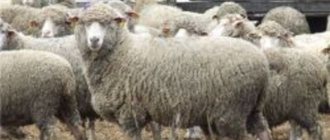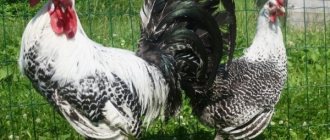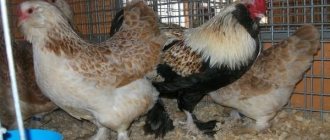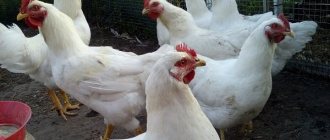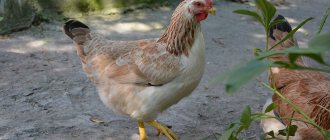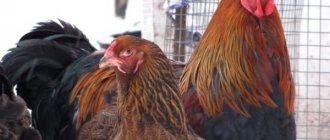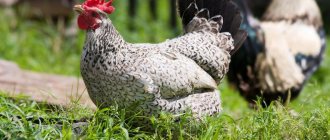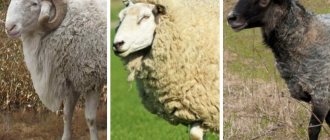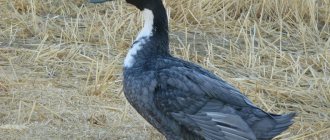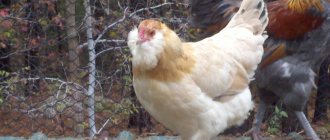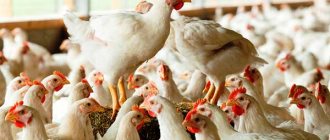The Mechelen Cuckoo breed of chickens, the description of which our article is devoted to, has been known for quite a long time. This is one of the largest varieties, capable of successfully competing with modern broiler crosses in terms of quantity and quality of meat products.
In the photo - chickens of the Mechelen Cuckoo breed, intended for producing high-quality meat products
Today we will talk about how these birds appeared, and why they are currently not very widespread in domestic backyards.
First, let's get acquainted with the main characteristics of the breed, collected in the table:
| Parameter | Characteristic |
| Class | Birds |
| View | Chickens (Gallus gallus L.) |
| Breed | “Mechelen cuckoo” (“Mechelen”, “Malin”, etc.) |
| Productivity type | Meat |
| Plumage color | Pied black and white (“cuckoo”) |
| Age of puberty | About 7-8 months |
| Egg production indicators | Up to 160 pcs. in year |
| Egg weight | Up to 65 g |
| Shell color | Pinkish beige |
| Hatchability and survival of young animals | Average (about 80% and 85-90%) |
| Growth rate of young animals | High |
| Live weight of an adult | Hens – up to 4.5 kg, roosters – 5.5-6 kg |
| Consumer qualities of meat | Very high |
| Sustainability | The bird is unpretentious, has good immunity, easily tolerates cold |
| Registration in the State Register of the Russian Federation | Absent |
Historical information about the breed
The Mechelen cuckoo is one of the most ancient breeds of poultry. Homeland - Belgium. The name sounds different in different languages, so the Mechelen cuckoo has a number of different names, one of the most popular is Malin. On the territory of the Russian Federation until 1917 it was famous by the name Cuco de Malin.
There is no reliable information about the creation of this breed; it is only known that it was bred around the 19th century. The ancestors are considered to be Brahma, Shanghai, Flemish and Chinese chickens. In Belgium they are proud of their birds; Malinov meat is considered a very expensive and tasty delicacy.
History of origin
The name of the breed reflects the specific color of the bird's plumage and the place of breeding - the environs of the Belgian city of Mechelen (Mechelln, Malin). Work on obtaining the variety has been carried out since the beginning of the 19th century . Breeders used the genetic material of Shanghai chickens, brahms, Flanders, local representatives with “cuckoo” colors, Flemish “hawks” and many others. The result was very large, unpretentious birds, capable of quickly building muscle mass with high consumer qualities.
The appearance of the Mechelen Cuckoos shows features of the various breeds used in the breeding process
“Cuckoos” came to Russia at the end of the century and quickly won the recognition of poultry farmers. In the country, the breed was called “Coco de Malin” (or simply “Maline”), which corresponded to the corresponding French designation of the area of origin. During the First World War, the European population of “raspberries” was greatly reduced, and the breed practically had to be revived from scratch. Now there are several lines that differ in plumage color and some other characteristics, but the birds of the original, “classical” species predominate both in number and in breadth of distribution.
Exterior of a bird
The Mechelen cuckoo is a meat bird. The weight of the male is 5 kg, the female is 4.5 kg. At the beginning of the 20th century, this breed was again bred in its homeland, but its appearance changed slightly. The first option is characterized by a leaf-shaped comb.
At the beginning of the 20th century, the German army needed high-quality food, so breeders decided to cross Malin with one of the Belgian fighting breeds. Males are much larger than Mechen cuckoos. The watchmen gave the Malins a real triple comb.
Today, there are quite a few descendants of Mechen cuckoos and Bruges Wächter and the single leaf-shaped comb is considered the standard. Many works by breeders prove that experiments are still underway to improve this breed. Scientists have set a goal to create a Malin that at 10 weeks will weigh approximately 4 kg of live weight.
In terms of weight characteristics, Mehen cuckoos are similar to broilers, but they are better than them in the following ways:
- absence of genetic diseases that lead to the death of birds;
- during breeding, the chicks retain their “parental” characteristics;
- there are no difficulties in working with the heart;
- savings in feed.
Some bird historians argue that they were called Cuckoos not because of such plumage, but because of the lack of incubation instinct.
Standard
They are strong birds with strong legs. Due to their enormous body mass, they are not very agile and cannot fly.
Signs of the Malin chicken breed:
- small head;
- leaf-shaped comb;
- orange or red eyes;
- the earlobes and earrings are red, rather large, slightly elongated;
- small light beak;
- the neck is long and strong, vertical to the body;
- the mane of males is practically undeveloped;
- the back is smooth and massive;
- the braids on the tail are poorly developed;
- the tail itself is not bushy;
- the wings are small, the shoulder girdle of laying hens is strong, the wings are pressed to the body, they are almost invisible behind the feathers;
- wide muscular chest;
- the belly is slightly convex and developed;
- paws are strong; the thighs and legs are muscular;
- the metatarsals are white-pink, but can also be dark gray, feathered only on one side;
- the plumage is dense, most often variegated coloring is found.
Watch a video about what Mechelen cuckoo chickens look like:
Breed colors:
- Cuckoo.
- Black.
- Hawkish.
- White.
- Lavender.
- Colombian.
- Silver.
- Golden.
Vices
Despite the fact that the breed is very rare in the Russian Federation, some signs still classify the birds as non-purebred birds:
- undeveloped small breasts;
- white lobes;
- not wide back;
- body in the form of a triangle.
Defects also include a very light shade of feathers, but in fact, some colors are light in themselves.
In Belgium they were able to breed dwarf Mechelen cuckoos, but it is even difficult to find photographs of them because they are rare.
Incubation
Malins are successfully bred in incubators. There are no special conditions or regimes for incubation. The incubation period is 21 days.
Table of temperature and humidity modes
| Period |
